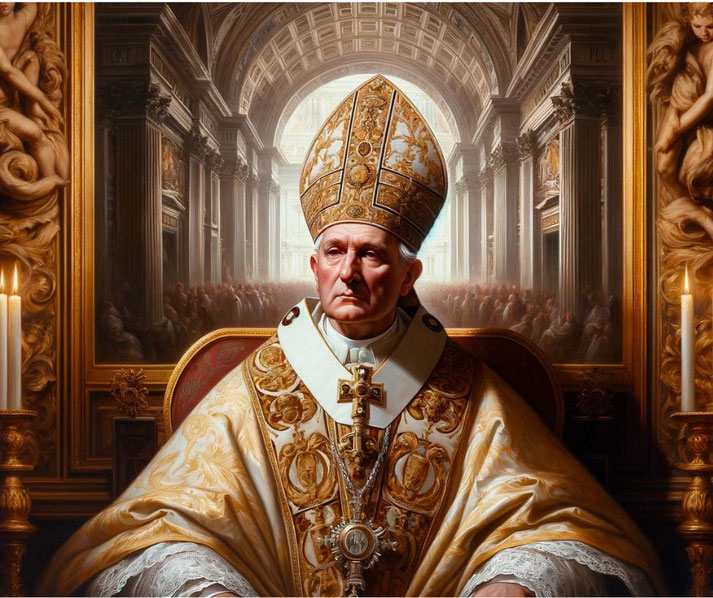When Napoleon's forces kidnapped the Pope in an attempt to destroy the power of the Church

On a fateful day in February 1798, the streets of Rome witnessed an unprecedented event in the struggle between church and state: the capture of Pope Pius VI by General Louis Alexandre Berthier, an audacious act carried out under the orders of Napoleon Bonaparte himself.
This abduction not only shook the foundations of the Vatican but also sent ripples through the corridors of power across Europe.
But what led to this extraordinary seizure of the most powerful religious leader in European history?
How did Berthier manage to seize the pontiff?
And what were the immediate consequences for the Catholic Church and European politics?
The tensions between the Church and France
The late 18th century was a period of profound upheaval in Europe, with the French Revolution, beginning in 1789, dramatically altering the continent's political landscape.
This period of radical social and political change marked the decline of absolute monarchies and the rise of democracy and nationalism.
Central to these transformations was Napoleon Bonaparte, whose meteoric rise to power began in the aftermath of the Revolution.
His military campaigns across Europe not only expanded French territory but also spread the revolutionary ideals of liberty, equality, and fraternity.

Meanwhile, the Papal States, governed by Pope Pius VI since 1775, found themselves increasingly at odds with the revolutionary tide emanating from France.
The Pope's refusal to recognize the French Republic and his denunciation of the secularization efforts, including the confiscation of church properties and the establishment of a state-controlled church in France, exacerbated tensions.
In response, French troops first invaded the Papal States in 1796, leading to the Treaty of Tolentino on February 19, 1797.
This treaty forced the Pope to cede significant territories and pay a hefty indemnity to France. However, the uneasy peace was short-lived.
The following year, in 1798, French resentment towards the Papacy intensified. Rumors and accusations of the Pope’s involvement in anti-French conspiracies provided the pretext for further action.
On February 10, 1798, Berthier entered Rome, declaring the establishment of the Roman Republic and ending the temporal power of the Papacy.
Who were the key players in the event?
Louis Alexandre Berthier, born on February 20, 1753, in Versailles, France, was a seasoned military man and a trusted ally of Napoleon Bonaparte.
A product of a military family, Berthier honed his skills in the French army, quickly rising through the ranks.
His extensive knowledge of military cartography and strategy made him an invaluable asset.
His loyalty and efficiency caught the attention of Napoleon, under whom Berthier served as Chief of Staff.
Known for his meticulous planning and organizational skills, Berthier played a pivotal role in many of Napoleon's campaigns, earning a reputation as a capable and reliable commander.

Pope Pius VI, born Giovanni Angelo Braschi on December 25, 1717, in Cesena, Italy, ascended to the Papacy on February 15, 1775.
His pontificate was marked by challenges and controversies, both within the Catholic Church and in its relations with emerging European powers.
Pius VI navigated the Church through the Enlightenment, a period of significant intellectual and cultural shifts.
He faced the suppression of the Jesuit order and grappled with the increasing secularization of European states.
His Papacy was also characterized by artistic patronage and an emphasis on maintaining the spiritual and temporal authority of the Vatican.
However, it was his staunch opposition to the revolutionary changes in France, including the Civil Constitution of the Clergy and the subsequent secularization policies, that defined his later years.
The capture of the Pope
Following the proclamation of the Roman Republic by Berthier on February 10, 1798, the Pope found himself in a precarious position.
Despite the dramatic changes unfolding around him, Pius VI refused to leave the Vatican, holding firm to his spiritual duties and authority.
As the new Roman Republic began to take shape, the French authorities saw the continued presence of the Pope as a potential source of dissent and a symbol of the old order.
Determined to consolidate their control over Rome and eliminate any possibility of a papal-led counter-movement, the decision was made to remove Pope Pius VI from power.
In the summer of 1798, French officials began to devise a plan for his capture, intending to transport him to France.
The actual capture took place on the night of July 5, 1798. French soldiers, under the cover of darkness, surrounded the Vatican.
In a swift operation, they entered the Papal apartments and took Pius VI into custody.
The 81-year-old Pope, frail and unprepared for such an event, offered no resistance.
He was swiftly escorted out of the Vatican and taken to the Certosa di Siena, a monastery in Tuscany.
This initial relocation was only temporary, as he was later moved further north, eventually ending up in France.
The capture of Pope Pius VI was unprecedented for a reigning Pope to be treated as a political prisoner, and this act symbolized the dramatic shift in power dynamics between the Church and the secular authorities.
For the French, this move was seen as a necessary step in securing the gains of the revolution and weakening the influence of the Church.
For the Papacy and its followers, it was a moment of profound crisis, challenging the very foundations of the Papal States and the traditional role of the Papacy in European politics.

How the European world reacted to the news
In Catholic circles, the capture of the Pope was met with widespread shock and consternation.
It was an act that seemed to defy the sanctity and inviolability of the Papal office. Many Catholics viewed the Pope's removal as a profound violation of religious freedom and an affront to the Church's authority.
Across Europe, particularly in regions with strong Catholic majorities, there was a sense of outrage and sadness.
The event became a rallying point for anti-French sentiment, as it symbolized the overreach of the revolutionary ideals and the disrespect for traditional institutions.
Among the political powers of Europe, reactions were mixed. While some of the more revolutionary governments and leaders saw this as a progressive step in diminishing the temporal power of the Church, more conservative states viewed it with alarm.
It raised concerns about the extent of French ambition and influence under Napoleon's leadership.
The event further complicated the already tense relationships between France and other major European powers, contributing to the geopolitical instability of the time.
Within the newly established Roman Republic and other French-controlled territories, the capture of the Pope was a signal of the triumph of secular over religious authority.
It was seen as a necessary step in establishing new social and political orders, free from the influence of the Church.
This shift had a lasting impact on the role of the Church in political affairs, significantly diminishing its temporal power and paving the way for the principle of the separation of church and state.
Pope Pius VI's imprisonment and sudden death
In August 1799, Pope Pius VI was transferred to the French city of Valence. The journey was arduous for the Pope, who was by then 81 years old and in poor health.
The conditions of his travel and the treatment he received during the journey were far from the respect traditionally accorded to his position.
Upon reaching Valence, he was confined in the citadel, a stark contrast to the Vatican's splendor.
His health rapidly deteriorated in these conditions, exacerbated by the stress and discomfort of his captivity.
Pope Pius VI passed away on August 29, 1799, in Valence. His death, occurring in a foreign land and under imprisonment, was a poignant symbol of the dramatic shift in the Church's status and influence.
The French Revolutionary Government, still in control of Valence, initially denied a traditional burial for the Pope.
His body was hastily interred in a simple grave in the local cemetery, without the ceremony and reverence usually afforded to a deceased Pope.
The death of Pope Pius VI in captivity had a profound impact on the Catholic Church and its followers.
It was an ignominious end to a pontificate that had spanned over two tumultuous decades.
The manner of his death and burial was seen by many as a final act of indignity by the French authorities towards the Papacy.
This event further fueled the resentment and resistance against the French revolutionary government and its policies, particularly among Catholic populations.
How significant was the event in Church history?
One of the most immediate effects of Pope Pius VI's ordeal was the reevaluation of the Papacy's role in world affairs.
The sight of a Pope being deposed and imprisoned by a secular power challenged the long-held perception of the inviolability of the Papal office.
This event catalyzed discussions within the Church about the nature of its engagement with political entities and prompted a strategic rethinking of its approach to international diplomacy.
Furthermore, the incident significantly influenced the Catholic Church's stance towards modernization and change.
The Church, which had been initially resistant to the ideas of the Enlightenment and the French Revolution, gradually began to adapt to the new realities of a Europe in flux.
This adaptation was crucial for the Church's survival and relevance in the changing political landscape of the 19th century.
On a broader scale, the treatment of Pope Pius VI highlighted the fragility of traditional institutions in the face of revolutionary ideologies.
It illustrated how revolutionary France sought to redefine the relationship between the church and state, promoting secularism and diminishing the temporal power of religious authorities.
This shift had lasting implications, influencing the development of the principle of the separation of church and state, a concept that became a cornerstone of modern democratic societies.
The legacy of Pope Pius VI's capture and death also resonated in the subsequent restoration and reorganization of the Papal States.
After the fall of Napoleon, the Congress of Vienna in 1815 led to the restoration of the Papal States, albeit in a Europe that was vastly different from that of the pre-revolutionary era.
This restoration, however, was temporary, as the unification of Italy in the latter half of the 19th century ultimately brought an end to the Papal States' temporal power.
What do you need help with?
Download ready-to-use digital learning resources
Copyright © History Skills 2014-2025.
Contact via email
With the exception of links to external sites, some historical sources and extracts from specific publications, all content on this website is copyrighted by History Skills. This content may not be copied, republished or redistributed without written permission from the website creator. Please use the Contact page to obtain relevant permission.





